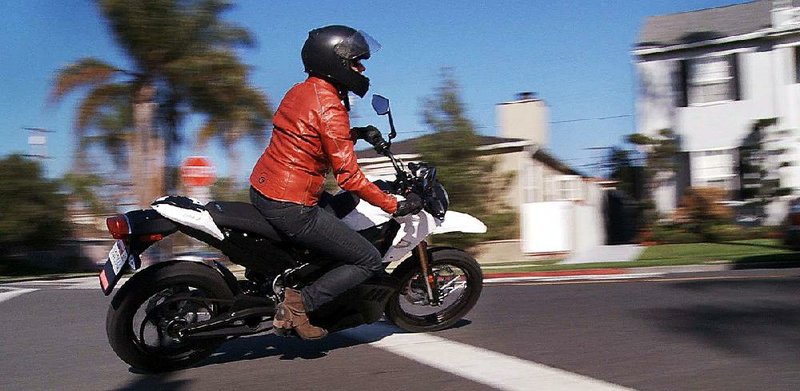LOS ANGELES — When Harry Mallin commutes to work on his motorcycle, he stops at gas stations only to pick up a Diet Coke.
He rides a Brammo Enertia, which won’t ever be mistaken for a loud, heavy “hog.” The Enertia is a plug-in electric motorcycle.
“I never have to stop at the pumps,” said Mallin, who rides 25 miles round-trip to his job as a lawyer in Kansas City, Mo.
Electric motorcycles, though still a rarity on the nation’s byways, have been available for years. But with new models coming out that can go freeway speeds and travel more than 100 miles on a single charge, electric motorcycles could be poised to move beyond novelty status.
Also helping to boost their prospects: the high cost of gasoline.
Hollywood Electrics, a leading seller of electric bicycles as well as motorcycles, said it sold more electric motorcycles in the first two months of 2012 than it did in 2010 and 2011 combined.
“It’s a perfect storm,” co-owner Harlan Flagg said. His best-selling electric motorcycle is the $14,000 Zero Motorcycles’ S ZF9, which can reach a top speed of 88 mph and travel up to 112 miles per charge.
“You’ve got gas prices going up, electric motorcycle technology developing and just some general interest with other mainstream manufacturers releasing electric vehicles,” Flagg said. “With the Nissan Leaf and Chevy Volt, people are starting to pay attention and take it seriously.”
It’s an industry that’s surely in need of a boost. As of last July, Zero Motorcycles of Scotts Valley, Calif., had sold just1,000 bikes in its five years in business. Brammo, of Ashland, Ore., said sales of its Enertia were only in the hundreds.
Scot Harden, vice president of global marketing for Zero Motorcycles, predicted that his company would sell more than 2,000 bikes this year. That’s a big increase, but still a small number in an industry that sold 312,000 street bikes in the U.S. in 2011.
Electric motorcycles cost less than 2 cents’ worth of electricity per mile to operate - considerably less than gasoline-fueled bikes. But the purchase price of electrics is much greater. It’s likely to take about 30,000 miles of riding one of the new, high-powered electric motorcycle models to reach cost parity with a comparable gas-powered bike, factoring in the price of the vehicle, maintenance and fuel costs, Harden said.
If major manufacturers get involved, the prices could come down. None of the major motorcycle makers has committed to an electric model for the U.S., but there are rumblings.
Honda Motor Corp. is currently leasing its Neo all-electric scooter to select businesses in Japan, and in November the company unveiled a prototype electric race bike called the RC-E. BMW has said it plans to take its first electric scooter to market within three years.
And KTM, the Austrian manufacturer best known for high-performance dirt bikes, is about to go into limited production of its first all-electric model, the Freeride E, which will be sold exclusively in Europe beginning this spring.
Whether the Freeride E will come to the U.S. “depends how it’s received in Europe,” KTM North America spokesman Tom Moen said.
For the time being, most electric motorcycle development is in the hands of niche firms. In May, Brammo will begin production of its Empulse sport bike, priced at $10,000 to $14,000, depending on range. The company said the Empulse is capable of 100-plus mph and 100 miles per charge in its top model.
The company also will be turning out the Enertia Plus commuter, an $11,000 electric model which will have an 80-mile range.
“Everybody wants to see and test-ride the new bikes,” said Bill Bartels, owner of Bartels’ Harley-Davidson in Marina del Rey, Calif., Brammo’s only dealer in the Los Angeles area.
Bartels said he added Brammo to his lineup last summer because it was “at the total other end of the spectrum of big, expensive Harley-Davidsons.”
Electrics might be a hard sell for fans of traditional cruiser and sport bikes.
“They don’t have electric NASCAR or electric Boeing 747s, so I’m assuming that the power is less,” said Ricky Castellon, 37, a Los Angeles tattoo-shop owner who rides his Honda CBR1000RR with his club, the Asylum Ryders.
He said his riding buddies “don’t ever talk about electrics. It would be like talking about a scooter.”
But William Funkhouser couldn’t be happier with the Zero S ZF9 he purchased in January. He’s had the bike less than two months and has already ridden it 1,200 miles, averaging 85 miles of range per charge.
“I have so much fun going to and from work,” said Funkhouser, 62.
He bought the Zero because he wanted to “go green” and felt guilty about driving his Land Rover.
Funkhouser said he so much enjoys his 14-mile commute from his home in Los Angeles to his teaching job at a San Fernando Valley middle school that he often takes 30-mile detours through canyons on his way home.
The enjoyment factor is probably key to the possible success for the vehicles, given that motorcycles are often bought for recreation rather than simple transportation.
“Electrics are the first real change in motorcycling in 100 years,” Brammo founder Craig Bramscher said. “At the end of the day, especially for existing motorcyclists, green is cool, but it isn’t the driving force. It’s, ‘Is it cool? Is it fun ?’”
Business, Pages 19 on 03/26/2012
